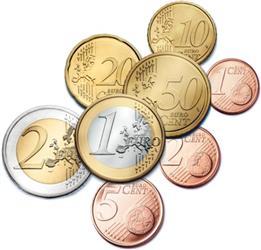Euro common side
At the 2666th Council meeting of Economic and Financial Affairs in Luxembourg
(on June 7, 2005) a number of important desicision concerning the euro coins were taken. According to the
Council, the common side of the bi-colour coins (1- and 2-euro) and the "Nordic gold" coins (10-, 20- and 50-cent)
represented the European Union before it was enlarged from 15 to 25 Member States in May 2004. On the basis of
new designs submitted by the Commission, the Council decided that the necessary technical preparations for the
amendment of the common side of these coins should be completed so as to ensure that all EU Member States will
in the future be represented. The common side of the smallest denomination coins (1-, 2- and 5-cent) represent
Europe in the world and are not affected by the enlargement of the European Union.
By taking this decision on a timely basis, the Council wanted to make certain that countries adopting the euro
in the future will be able to mint coins with the new common side. The existing euro-area Member States will also
change over to the new common side once they have completed all technical preparations. The new common side will
only be used for future coin production. All euro coins already in circulation remain perfectly valid and will
not be replaced. The new European map present on the new common sides of these denominations feature the islands of Malta and Cyprus, though they are disproportionately large. These countries entered the Euro Zone on 1 January 2008.

At the same Council meeting, it was also agreed that since euro coins circulate
throughout the euro area, Member States should put a clear indication of the issuing Member State on the national
side by means of the Member State's name or an abbreviation of it. Member States should refrain from repeating
the denomination of the coin, or any parts thereof, or the currency name or its subdivision, on the national side,
unless a different alphabet is used. The edge lettering of the 2-euro coins can bear an indication of the
denomination, provided that only the figure "2" and/or the title "euro" are used.
Member States should inform each other on the design of new national sides, including the edge letterings,
before they formally approve these designs. To this effect, new designs should be forwarded to the Commission
which will without delay inform the other Member States as appropriate. These rules should apply to all future
national sides and edge letterings of both normal and commemorative euro circulation coins issued after the
adoption of these conclusions. No changes are required to existing national sides.
Turkey wiped-off the map
The new euro coin design cutting Turkey from the European map drew criticism from lawmakers after two members
of the European Parliament raised the issue of the missing country. European Union officials were accused of
"political geography" after Turkey (but not the Ukraine, Belarus and Moldova) disappeared from the map of Europe
designed for the new euro coins. Papers given to Euro-MPs under Brussels open information rules show that the
European Commission proposed a standard format map of Europe extending as far as the Caspian Sea and including
Turkey. But, following the intervention of unnamed national governments, Ankara was short-changed in the final
design and was cut from the map altogether.
Marco Cappato, an Italian Liberal Euro-MP, is angry that Turkey, an EU membership hopeful, has been removed
from a design that includes Moldava and Belarus, countries with poor human rights records. He believes the
omission is a deliberate "provocation" by euro zone members, such as France, who are hostile to Turkish EU entry.
"They have deliberately and secretly wiped Turkey off the map. To come up with this apparently geographical
design they were obliged to put Cyprus 500 kilometres west of where it actually is," he said. "It is politics
not geography to depict non-member states of the EU, including authoritarian, even dictatorial, regimes, and
not Turkey, with which membership negotiations have begun."
A Brussels spokeswoman refused to make "pointless" comment on differences between Commission's original map
and the final design. "The commission proposed a new map and the member states took a decision," Amelia Torres,
a commission spokeswoman, said. Turkey has made little progress toward becoming an EU member since entry talks
began in 2005 and many EU politicians now favour a "privileged partnership" rather than full membership.